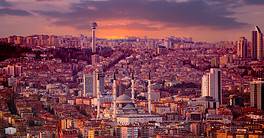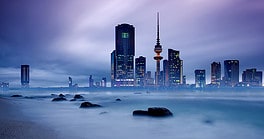Long a beacon of prosperity in Africa, the tiny island nation needs fresh government initiatives to boost growth.

There was an aura of optimism in October when Mauritius reopened its borders to international tourists after months of isolation due to the Covid-19 pandemic. “We have been waiting for this day for so long,” said Tourism Minister Steven Obeegadoo.
It was a symbolic moment for the tiny island nation. Prior to the pandemic, the tourism and hospitality sector employed nearly a quarter of its 1.3 million population and delivered 24% of gross domestic product (GDP). Reopening to tourists was a landmark on the country’s journey to rebuild the economy, which contracted by 15% in 2020. The International Monetary Fund (IMF) projects a rebound to 5% GDP growth this year.
Part of that swift rebound owes to the government’s sound response to the pandemic. Mauritius has been hailed as a success story in containing Covid, boasting one of the highest vaccination rates in the world: 68% of the population is fully vaccinated, and 89% has received at least one dose. “The vaccination campaign has helped in boosting confidence,” says Nico van Zyl, managing director at Sovereign Group, a Mauritius-based business advisory firm.
That confidence will be a booster as Mauritius embarks on the road to economic recovery and renewal. For decades a beacon of political and socioeconomic prosperity in Africa, Mauritius attained high-income status in 2020. Now, according to World Bank analysis, it needs a new generation of reforms, more complex than the first. “Mauritius needs to focus not on big, stroke-of-the-pen reforms,” states a World Bank report, suggesting, instead, that the country turn to fine-tuning multiple, mostly well-functioning institutions and improving microeconomic policies and policy coordination to benefit from new synergies.
Part of the strategy in the immediate future involves investing $1.4 billion in priority projects to spur economic activity and chip away at the current 9.2% unemployment rate. The 2021-2022 budget includes projects along environmental and social lines—flood mitigation, green energy, water treatment and 12,000 new units of affordable housing—as well as traditional big infrastructure, such as the Rivière des Anguilles Dam. Half a billion is targeted to transportion projects alone. The country, in fact, wants to be a leader in Africa in transitioning to electric vehicles. Importing electric vehicles is now duty-free, while registration fees and road taxes have also been reduced.
From 2009 to 2019, exports dropped from 57% to 40% of GDP. The country has lost market share in all of its largest export sectors, including textiles, tourism, financial and business services, information and communications technology (ICT) and seafood processing. According to the World Bank Mauritius Report for 2021, the ratio of investment to GDP has fallen over the past decade, from 25% to 21%. Consumption remains the main driver of growth, now more than ever, having increased from 84% of GDP in 2009 to 95% in 2019.
As in other developed nations, the population is aging. Those aged 60 and older comprise 18.4% of the total population for Mauritius, according to UN statistics, putting it between the UK at 18.3% and Belgium at 18.7%. The average across Africa is just 5%.
“The government should anticipate huge pressure on public finances in terms of expenditure on pensions,” says Reena Anjali Bappoo-Huneewoth, senior regulatory compliance officer at global consultancy Maitland. She suggests fostering late-career entrepreneurship as one way to ease the pressure.
“Challenges for higher growth include systemic constraints to investment,” observes L. Amédée Darga, StratConsult managing partner, pointing to its relatively small market and high labor costs compared to most African nations.
The ratio of public debt, currently around $9 billion, is at 95% of GDP. Myriam Blin, an economist at the Charles Telfair Campus in Mauritius, an international outpost of Australia’s Curtin University, reckons that although Mauritius’ public sector debt is undeniably high, it has been denominated mostly in the local currency, the rupee. That has served as a buffer.
Increasingly, however, borrowings are in foreign currencies. “This has to be closely monitored,” Blin notes, “especially given potential interest rate increases in the future.”
Reslience and Democracy
Given its many challenges, how has Mauritius surpassed so many of its regional peers? “Mauritius has certain specific characteristics that could position the country at the forefront of an innovative and sustainable recovery,” says Blin.
One is a strong foundation in parliamentary democracy. Although a recent report by V-Dem Institute at Sweden’s University of Gothenburg put Mauritius among the world’s “top ten autocratizing countries,” others see it differently. “Though increasingly unhappy about political conditions in their country, Mauritians remain strongly committed to democracy,” says van Zyl.
Darga says the constitutional and institutional pillars which made Mauritius a democracy since independence remain stable, even if the quality of governance is declining. “Democracy is still vibrant,” Darga counters. Mauritius further features an independent judiciary, quality infrastructure and institutions, a culture of economic openness, resilience and adaptability and strong international ties with Europe, China and India.
The administration wants the financial sector to play a central role in economic recovery. Notably, finance was the only sector besides ICT that registered positive growth in 2020—if only a paltry 1.1%. With no capital gains or inheritance taxes and relatively high personal safety, Mauritius hosts more millionaires than nearby Ethiopia or Ghana—roughly 4,400, according to AfrAsia Bank Africa Wealth Report 2021. In October, the Paris-based Financial Action Task Force removed Mauritius from its “grey list” of countries accused of facilitating money laundering and terrorism financing. The delisting enhances the country’s reputation as a reliable international financial center that attracts reputable business.
The government’s investment plan aims not only to boost economic development but also build deeper resilience in the medium term as well as developing the blue economy, for example, and building green-energy capacity. The impetus stems, in part, from the country’s extreme vulnerability to external shocks and natural disasters. A portion of the funds will be dedicated to agricultural development, for example, in order to cut the country’s dependence on food imports—currently at 70%.
“Resilience provides comfort and confidence to the international community that Mauritius remains a viable corridor for investment into Africa,” says Bappoo-Huneewoth. And it may encourage the tourists to return, as well.



